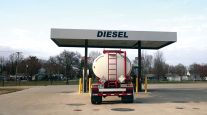Diesel Average Dips 0.7¢ as Crude Oil Price Stalls
This story appears in the May 2 print edition of Transport Topics.
The average retail price of U.S. diesel declined for only the second time in about four months last week, slipping 0.7 cent to $4.098 a gallon on the coattails of relatively stable crude oil prices, the Department of Energy said.
The gasoline average, meanwhile, increased for the sixth straight week, rising 3.5 cents to $3.879 a gallon, DOE reported April 25 after its weekly survey of 350 U.S. filling stations.
The diesel and gas averages now have both risen in 19 of the past 21 weeks. Diesel is now $1.02 a gallon more expensive than it was a year ago and gasoline has gained $1.03 a gallon in the past 12 months, according to DOE.
Crude oil last week oscillated between $112 and $113 a barrel on the New York Mercantile Exchange, marking a period of relatively stable — if high — prices. Diesel, supported by adequate distillate stockpiles, eked out a dip during the window of oil stability while gas, pressured by lower-than-average stockpiles, jumped, a DOE analyst said April 27.
“U.S. distillate stocks are in the high range; they’re above the five-year average,” said Neil Gamson, a DOE analyst who focuses on diesel prices. “Gasoline stocks, on the other hand, are towards the low end.”
Distillate stocks for the week ended April 22 were about 147 million barrels, above the five-year average of about 141 million barrels, according to DOE’s latest weekly fuel report.
U.S. gasoline stockpiles, however, were about 206 million barrels last week. The five-year average is about 212 million barrels, DOE data show.
As for crude oil prices, “they’ve been relatively high but . . . they’ve been fairly flat.” However, “that could change,” Gamson said.
Crude oil futures on the New York Mercantile Exchange remained near a 31-month high last week, but the settlement price for those contracts hovered within a $1.50-per-barrel range from April 20 to April 27, according to data gathered by Bloomberg News.
The 14 trading days before that included erratic jumps and dips that sometimes changed the price of crude by more than $3 a barrel from one day to the next, Bloomberg data show.
Gamson at DOE said that these volatile movements, most of which served to push up oil prices sharply, led to a pass-through spike for transportation fuels.
Despite the persistently high cost of diesel, the head of one fleet said that he wouldn’t hit the panic button until prices were near $5 a gallon.
“I think, as you get closer to $5, that’s where we would start looking at something drastic,” said Robert Pemberton, president of a 200-truck truckload carrier called Pemberton Truck Lines. “We might look harder at [auxiliary power units]; we might revisit [maximum] truck speed.”
In the meantime, Pemberton, based in Knoxville, Tenn., is maxing out aerodynamic options on its tractors and trailers.
“It’s basically skirts and fairings for the tractors, and the trailer fairings as well,” Pemberton told Transport Topics April 27. A fully rigged tractor-trailer with these aerodynamic additions gets about 7.2 mpg, Pemberton said — about 0.7 mpg better than a rig without the additions.
Meanwhile, executives at the nation’s largest for-hire truck fleet, UPS Inc., said on the company’s first-quarter conference call that they are applying lessons learned during the 2008 fuel bubble to their business today.
UPS’ strategies include shifting fuel reimbursement out of surcharges and into base rates, and leveraging route optimization software to conserve fuel.
Kurt Kuehn, UPS’ chief financial officer, said that “in general, [UPS] surcharges are lower because we have continued to move some of that rate into the core rates.”
In addition, the “technology we put in to optimize and the focus on reducing fuel consumption is paying some real dividends,” Kuehn said on the April 26 call.
Meanwhile, another fuel analyst said that an uncharacteristic price spread between two widely refined types of crude oil is influencing fuel prices by creating unusual import/ export incentives for U.S. buyers.
“There are two different types of crude used to peg fuel prices: Brent in Europe and West Texas Intermediate in New York,” said Roger McKnight, senior petroleum analyst with En-Pro International, Oshawa, Ontario.
NYMEX crude-oil futures contracts represent batches of WTI crude. Those contracts closed at $112.76 a barrel on April 27, according to Bloomberg News. On the same day, contracts underpinned by Brent crude closed at $125.47 a barrel on the ICE-Futures Europe exchange in London.
Brent crude oil is usually cheaper, McKnight said.
The higher price for the European blend makes importing that oil or its byproducts a less attractive option for American buyers. Cheaper WTI means that exporting domestic crude, or fuel made from it, is more profitable for U.S. businesses, McKnight said.
“When [U.S.] refiners are using lower-cost crude to make transportation fuels, it makes the export factor quite attractive,” McKnight told TT.
“Normally, this is the time of year when gas prices go up and diesel goes up in sympathy, just because of the slipstream effect,” said McKnight. Gasoline “normally . . . drops off severely in June, dragging down diesel prices as well.” Because of unusual import/export incentives, he added “this year it may be different.”




